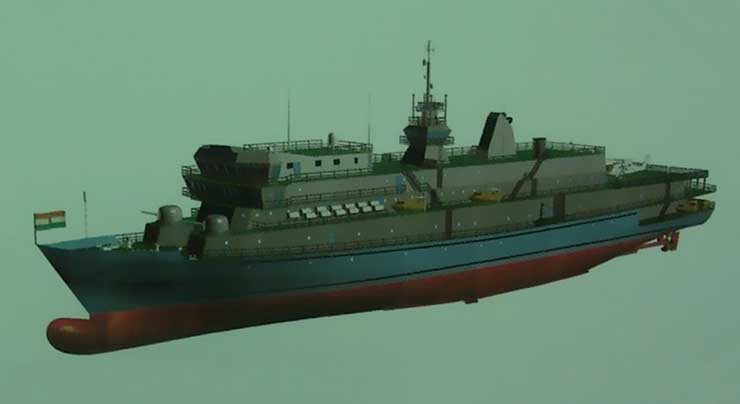
With the notification of the third ‘positive indigenisation list’ of 101 items on April 07, 2022, the Department of Military Affairs (DMA) has so far banned import of 310 defence items in the last two years. According to an official release, the new list includes ‘complex equipment and systems which are being developed and likely to translate into firm orders over the next five years’.
The ban will come into effect in phases stretching up to December 2027.
Much like the first two lists of 101 and 108 items—numbers considered auspicious in Hindu and some other mythologies—which were notified in August 2020 and May 2021, the third list too contains an assortment of items, ranging from devices like Deep Seaside Towing Winch, Flares and Chaffsto to complex systems like Light Weight Tank, Cadet Training Ship, Naval Utility Helicopter, and Next Generation Fast Attack Craft.
The aforesaid official release claims that since the notification of the first two lists, contracts for 31 projects worth Rs 53,839 crore have been signed and Acceptance of Necessity (AoN) for 83 projects worth Rs 1,77,258 crore has been accorded.
More promisingly, procurement proposals worth Rs 2,93,741 crore are slated to be processed in the next five to seven years. The domestic defence industry is elated.
While these lists showcase the industry’s capabilities and the armed forces’ cautious optimism that their requirements can be met indigenously, it is arguable if listing out of the items that cannot be imported serves any specific purpose or plays a crucial role in furthering the cause of Atmanirbharta, or self-reliance, in defence production. It is not as if the MoD may have merrily kept importing the embargoed items, as and when required, in the absence of these lists.
The Defence Procurement Procedure (DPP) 2016 specifically required the MoD to accord priority to procurement of items that were, or could be, indigenously designed and developed. The Defence Acquisition Procedure (DAP) 2020 has made this rule more stringent. Consequently, it is only after ruling out this possibility, as well as the possibility of manufacturing the desired items in India through transfer of technology from the foreign equipment manufacturer, that permission can be granted for importing an item.
Considering that by MoD’s own admission, the items included in the three ‘positive indigenisation lists’ are either already being made, or can be made, in India, the aforesaid rule that has existed for at least six years now would have anyway blocked any attempt to import the listed items.
Some analysts hold the view that these lists serve the purpose of advance intimation as regards the items that the armed forces will buy only from the Indian industry after the cut-off date from which the ban on import comes into effect, so that the interested companies could prepare themselves to meet the armed forces’ requirement. This is unconvincing as the objective of sensitising the industry about the needs of the armed forces over the next 15 years was to be served by the Technology Perspective and Capability Roadmap (TPCR).
The TPCR was first notified in 2013 and subsequently revised in 2018 to include information about the estimated quantity and broad specifications of the equipment required by the armed forces to enable the industry to acquire necessary research, design, development, and manufacturing capabilities either on its own or by entering into collaborative agreements with the foreign manufacturers. There is no clarity on whether the ‘positive indigenisation lists’ supplant or supplement the last TPCR of 2018.

In fact, the ‘positive indigenisation lists’, suffer from the same drawbacks which undermined the usefulness of TPCR 2013 in the sense that crucial information concerning the quantity and specifications of the embargoed items is missing from these lists. For example, it is difficult to imagine how an Indian company can figure out what is meant by ‘Integrated Stand for Instrument System’—one of the items on the list—and position itself as a potential supplier even in the absence of specifications of the system and the quantity required.
Other examples include ‘COMINT (Ship Based)’, ‘Stabiliser for Ships’, ‘Spotting Scope System’, ‘See Through Armour’, ‘Integrated Stand for Instrument System’, and ‘LUNA (Optical Landing System – Aircraft Carrier)’. These are among the 101 items included in the latest list, whose import is to be banned from December 2022 to 2027 respectively. The nomenclature of these items does not give adequate indication of what is expected of the industry by the armed forces.
True, the latest notification also says that ‘To maintain timelines for production, hand holding of industry by the defence services will be encouraged’, but it means little in the absence of a defined system of engagement.
It is unrealistic to expect the Indian private sector industry to undertake risky projects unless there is some assurance of orders. The fact that AoNs worth Rs 1,77,258 crore have been accorded and procurement proposals worth Rs 2,93,741 crore are likely to fructify in the next five to seven years, which implies a maximum average annual expenditure of Rs 60,000 crore, may not be reassuring enough for two reasons.
One, it is well established that not all AoNs result in the award of contract. And two, after allowing for the share of the Defence Public Sector Undertakings which inevitably garner a large chunk of the business, and the committed liabilities on account of the ongoing contracts, not much money may be left for procurement from the private sector in the coming years.
To add to this uncertainty, the latest notification also says that ‘In the event the Domestic Industry is not able to supply equipment in the stipulated time frame/ quantity, or where there are inadequacies in the equipment affecting safety of troops, specific cases for import could be taken up to meet immediate requirement, based on the recommendations of Defence Indigenisation Committee’.
The message is clear: the armed forces will not wait forever for the Indian industry to manufacture the items whose import has been banned.
This somewhat disconcerting analysis is not intended to disparage MoD’s efforts to achieve self-reliance by promoting indigenous design, development and manufacturing of the equipment, weapon systems, assorted platforms, and capabilities required by the armed forces, but to point out that it would require a better coordinated multifaceted effort to achieve self-reliance in defence. To believe that notification of the ‘positive indigenisation lists’ at regular intervals is an important step in reaching that goal is ingenuous.
– The author is Ex-Financial Advisor (Acquisition), Ministry of Defence. The views expressed are personal and do not necessarily reflect the views of Raksha Anirveda















